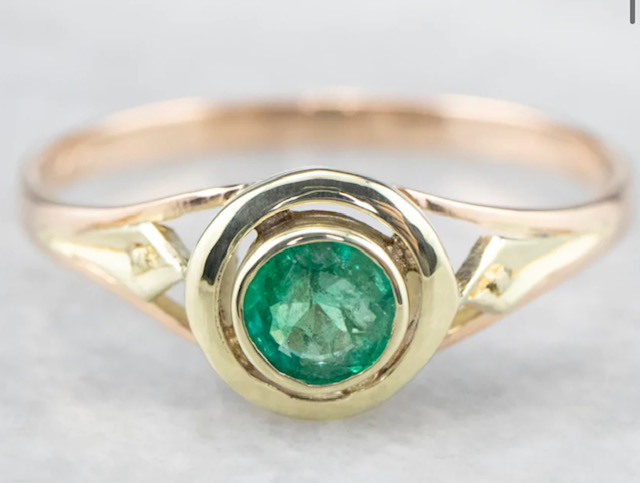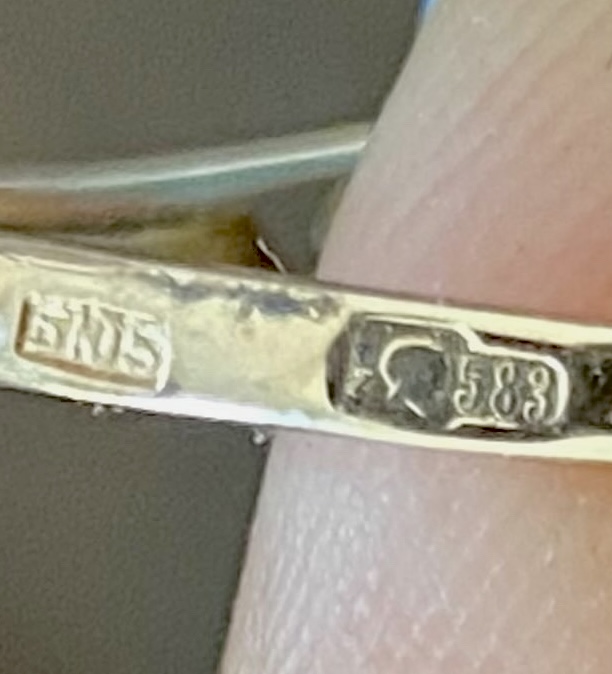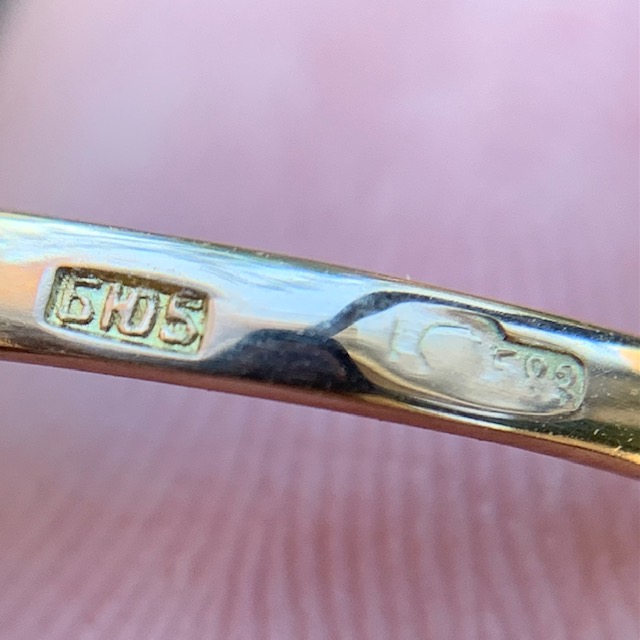Help requested on ring with early Soviet hallmarks, please
Posted: Fri Aug 19, 2022 2:20 pm
Greetings, and thank you in advance for your time in helping me put together the puzzle pieces on this possible early Soviet ring! I've done a lot of homework before coming here to the forum, but my resources are limited. I'm hoping someone(s) here might be able to confirm what I have found and fill in the blanks. Be forewarned, I've gone down many rabbit holes in attempt to work this out on my own so I have a lot of thoughts going in on this.

I purchased this 14K Emerald Target/Bullseye ring from a jeweler strictly because I thought it was cute. Please note that this particular jeweler specializes in vintage and antique jewelry and often places new gemstones into antique/vintage settings if the original stones were removed or badly damaged. According to their notes, this ring came to them with this emerald, and while they nor I have any reason to think it is a replacement stone, it is still entirely possible. The band to the split shank to the underside of the ring is rose gold while the upper bullseye layer and lifted center daggers between the split shank are green gold.

This is unfortunately the only semi-decent photo I have of the ring's hallmarks pre-sizing. It needed to be sized down 2 sizes to fit my largest finger, and while my jeweler took great care by sizing on the side, the gold standard mark was partially destroyed as you will see on the following photo. What I know about the assay stamp: the worker's head with hammer places it to 1927-1959. It is also millesimal .583 fineness aka 14KT.
Questions: Using this photo above, do you have any thoughts on assay office? When do region of assay marks ever leave the Greek alphabet system in favor of Russian Cyrillic, or even do they ever? I've found some conflicting information online from sites that require a tablespoon of salt when it comes to utilizing information as fact.
I have used process of elimination to know what it is not.To me, it looks very much like a hybrid of 7 and 6, or a zeta in the Greek alphabet. I have seen the zeta referenced once only and that was in relation to silver. It placed the Zeta as Baku assay office.
Does/did Baku actually have an Assay office and if so, when would it have been in operation?
I have also found assay marks in Cyrillic in more recent pieces (hence my question about that change from Greek); if that is the case, it looks like the italicized lowercase version of Ge (Г г), derived from the Greek Gamma. I have seen Г used in relation to Tbilisi (unsure if Cyrillic or Greek uppercase Gamma), but again, the source is dubious.

These are the hallmarks as they are today (yes, I might have cried a little at the partially destroyed mark).Thankfully the maker's stamp is fully intact, and I hope I am accurate that it reads БЮ5 for Baku Jewelry Factory 5.
Question: Do you know when the Baku Factory was operating?
Pairing both marks together, I can say this ring reads as being made in Baku (now in Azerjaiban) in 1935, 1945, or 1955. It would make the most sense for it to also be assayed in Baku rather than traveling to Tbilisi for the gold standard mark, which begs the questions- did Baku have an operating assay office at this time and what do the assay marks look like?
Style wise, I have seen many Western European Art Deco target/bullseye pieces from the 1920's-1930's. White metals were all the rage in the '20's, but there was definitely a major comeback of the yellow metals in the '30s. This has me inclined to think this was most likely made in 1935, but I need feedback on factories and region of assay to be sure. Is there something else I should be taking into consideration while attempting to date this ring? What say you, experts in this forum? Am I on to something with a true Soviet piece?
If you've made it this far, dear reader, bless you! I know this is A LOT, but I'm hoping this topic could be a good resource for others at some point in the future.

I purchased this 14K Emerald Target/Bullseye ring from a jeweler strictly because I thought it was cute. Please note that this particular jeweler specializes in vintage and antique jewelry and often places new gemstones into antique/vintage settings if the original stones were removed or badly damaged. According to their notes, this ring came to them with this emerald, and while they nor I have any reason to think it is a replacement stone, it is still entirely possible. The band to the split shank to the underside of the ring is rose gold while the upper bullseye layer and lifted center daggers between the split shank are green gold.

This is unfortunately the only semi-decent photo I have of the ring's hallmarks pre-sizing. It needed to be sized down 2 sizes to fit my largest finger, and while my jeweler took great care by sizing on the side, the gold standard mark was partially destroyed as you will see on the following photo. What I know about the assay stamp: the worker's head with hammer places it to 1927-1959. It is also millesimal .583 fineness aka 14KT.
Questions: Using this photo above, do you have any thoughts on assay office? When do region of assay marks ever leave the Greek alphabet system in favor of Russian Cyrillic, or even do they ever? I've found some conflicting information online from sites that require a tablespoon of salt when it comes to utilizing information as fact.
I have used process of elimination to know what it is not.To me, it looks very much like a hybrid of 7 and 6, or a zeta in the Greek alphabet. I have seen the zeta referenced once only and that was in relation to silver. It placed the Zeta as Baku assay office.
Does/did Baku actually have an Assay office and if so, when would it have been in operation?
I have also found assay marks in Cyrillic in more recent pieces (hence my question about that change from Greek); if that is the case, it looks like the italicized lowercase version of Ge (Г г), derived from the Greek Gamma. I have seen Г used in relation to Tbilisi (unsure if Cyrillic or Greek uppercase Gamma), but again, the source is dubious.

These are the hallmarks as they are today (yes, I might have cried a little at the partially destroyed mark).Thankfully the maker's stamp is fully intact, and I hope I am accurate that it reads БЮ5 for Baku Jewelry Factory 5.
Question: Do you know when the Baku Factory was operating?
Pairing both marks together, I can say this ring reads as being made in Baku (now in Azerjaiban) in 1935, 1945, or 1955. It would make the most sense for it to also be assayed in Baku rather than traveling to Tbilisi for the gold standard mark, which begs the questions- did Baku have an operating assay office at this time and what do the assay marks look like?
Style wise, I have seen many Western European Art Deco target/bullseye pieces from the 1920's-1930's. White metals were all the rage in the '20's, but there was definitely a major comeback of the yellow metals in the '30s. This has me inclined to think this was most likely made in 1935, but I need feedback on factories and region of assay to be sure. Is there something else I should be taking into consideration while attempting to date this ring? What say you, experts in this forum? Am I on to something with a true Soviet piece?
If you've made it this far, dear reader, bless you! I know this is A LOT, but I'm hoping this topic could be a good resource for others at some point in the future.
